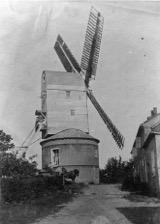- Screen Colours:
- Normal
- Black & Yellow

The mill in the photograph stood at the top of Mill Lane. It was a postmill, so called because the mill machinery stood on a central post - made of sweet chestnut in this Benhall mill. Postmills were the first windmills, introduced into the UK in the 12th century. Hundreds were built in Suffolk alone. This Benhall mill, built in 1736, would have been altered at some time in order to fit the fantail, the device, patented in 1745, which allowed the sails to be turned automatically to the wind. Previously, postmills had to be turned to the wind by the miller, using a long pole. The mill at Thorpeness is a good example of a surviving postmill with fantail.
Benhall folk may have called the mill in the photograph “the new mill” because when it was built, in 1736, an older windmill was taken down. It stood near the Aldeburgh Road at Friday Street, just where the road crosses the railway line. We may never know why it was necessary to build another mill. And the “new” mill could have been just one more in a succession of Benhall mills stretching back to the 12th or 13th century. One day we may find out more.
Before windmills, corn was laboriously ground by hand within each household, if there was no watermill nearby. Windmills allowed the production of flour to be monopolised, because only the rich could afford to build such a large and complex structure. The grinding of corn by hand was actively discouraged, even suppressed, once milling was mechanised. The miller paid rent to the local lord of the manor. Farmers paid the miller to grind their corn, in cash or in kind - a proportion of the flour. Milling was often combined with baking and some millers were also farmers. The plea, in the Lord's Prayer, “Give us this day our daily bread” had a very real and powerful meaning for our ancestors. Bread was the staple of the medieval diet; the routines of seedtime and harvest determined the life of the village, the success of failure of the corn crop, the price of grain and flour, were matters of life and death; millers were powerful, central figures in the rural economy featuring in many traditional songs and stories, not always to their advantage.
Who owned and operated the mills in Benhall is a subject for more research. Millers recorded at the “new” mill - who may or may not have been owners - include David Reynolds, 1853 to 1868; Robert Bloomfield, 1883 to 1896; W.M.Balls, 1908; and J. G. Bloomfield, 1925.
Local milling declined everywhere from the 1870s following the import of bulk grain from Russia and Canada, when steam mills were built close to the docks. This made supplies of flour more secure at the same time as the railway network was making regular distribution easier; fluctuating prices and local gluts and scarcities of grain were gradually consigned to history. The day of the windmill was over and the postmill in Benhall was demolished in the 1920s.
Research by Brenda, Hilary, Pauline, Derek, Eve and Joan of the History Group.
Photograph copyright The Mill Archive